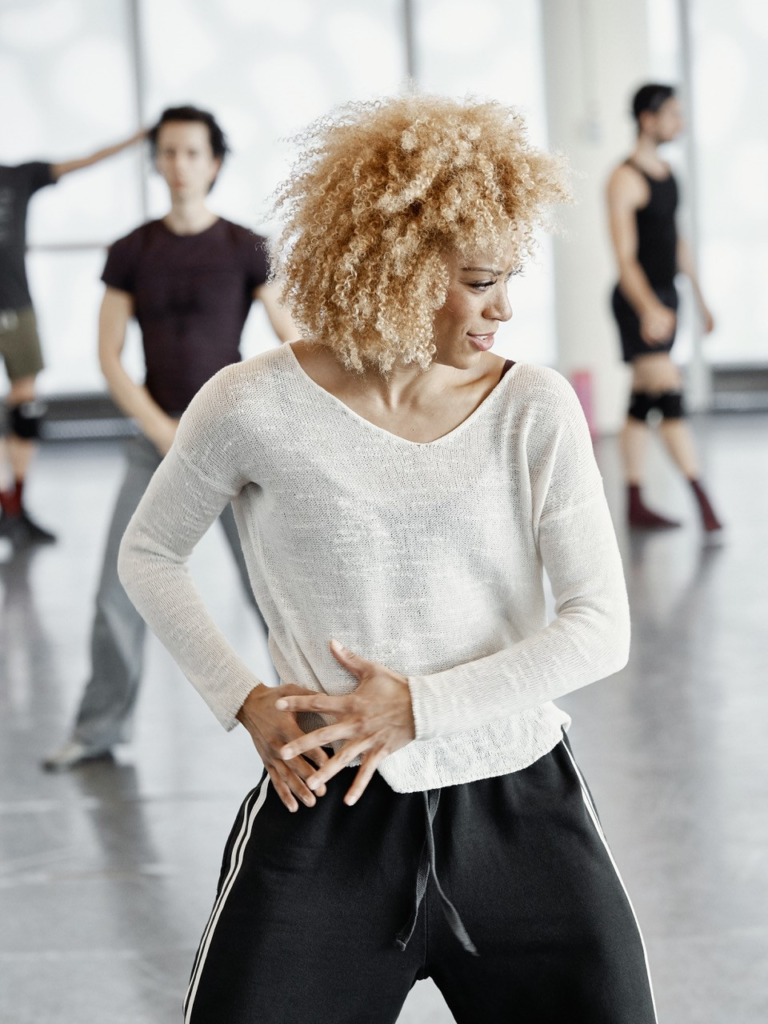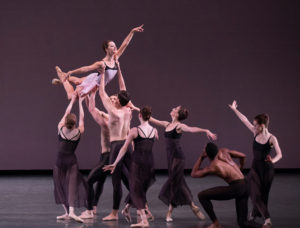Musical Choices: Two top ballerinas who are inspired to choreograph - Vancouver Ballet Society
- Home
- Features 2020 - 2023
- Musical Choices: Two top ballerinas who are inspired to choreograph

By Elaine Gaertner
The term “musical” is frequently used to describe dancers and their performances. For Lauren Lovette of New York City Ballet and Vanesa Garcia-Montoya Ribala of Les Grands Ballet Canadiens de Montréal, it can be said that each personifies many different facets of musicality: rhythmic precision and the converse ability to anticipate or delay a movement to highlight its effect; delineation of musical phrases; reflecting the accents and dynamics of the music; and projecting transcendent expression to skillfully transform the dance into the embodiment of the music. These ballerinas have risen through the ranks to become exceptional interpretive artists who are truly musical — and now, at the top of their game, they are emerging as talented choreographers, too.
What drives these two women to accept choreographic projects while still under contract to dance for many hours every day? Both have performed the works of the masters of 19th- and 20th-century choreography, but, now, have a passion to go beyond interpreting established repertoire and to create themselves. With a deep connection to music, each considers the musical score an indivisible partner in their creations.
Lauren Lovette, born in California, trained at the School of American Ballet in New York and in 2010 was hired for the corps of New York City Ballet. In 2015, she was promoted to principal dancer and in 2016 presented her first choreography for NYCB. She has also created works for Vail Dance Festival and ABT Studio Company.

As for her musical background, a few years of piano lessons as a child and a music history class in ballet school were followed in adulthood by guidance from experienced musicians and colleagues. Her music teacher at the School of American Ballet, Jeffrey Middleton, was a mentor during her first choreographic venture.
Lovette belongs to a small group of present-day choreographers who consider music the starting point for choreography, and its primary inspiration. According to Lovette, the music is “inseparable from my choreographic vision.” Her use of music, she explains, is first “a reflection of the composer’s intent, feelings and personal journey,” and honouring the integrity of the score is essential to her process. “I try to read about what the composer intended when the music was written, as well as what he/she may have been going through on a personal level while developing the composition.” But, ultimately, as the choreography develops, “the music infuses my own intent.”

Musical choices for New York City Ballet commissions have included a lush mid-19th-century romantic gem by Robert Schumann, written for his wife, Introduction and Concert Allegro, Op. 134, in her ballet For Clara (2016). Influences from the baroque and modern eras as well as 21st-century minimalism combine in an exhilarating score by British composer Michael Nyman, with three movements from his Concert Suite from Prospero’s Books accompanying Not Our Fate (2017). Powerful percussive sections blend with ethereal eastern and western harmonies in a violin concerto by Chinese composer Tan Dun, Fire Ritual, which Lovette chose for her ballet The Shaded Line (2019). Lovette has also choreographed to music by New York-based Caroline Shaw, a composer she admires for her “ability to creatively adjust like water,” a reference to the shifting colours and textures of her compositions.
Lovette says that, as a student, the School of American Ballet nurtured her “love of interpreting the music through dance as influenced by George Balanchine and Jerome Robbins.” Her musical choices as a dancemaker have clearly been shaped by these iconic choreographers. Scores chosen for her ballets tend to be expressive, thoughtful, relevant and significant musical compositions that could also have been embraced by Balanchine and Robbins. The music Lovette creates to, she said, provides “a call to dance.”
In March, Lovette announced in a press release that she is leaving New York City Ballet, and “plans to work exclusively on new choreography and other creative endeavors.” Her final performance with NYCB will be on October 9, 2021.
Vanesa Garcia-Montoya Ribala trained at the Real Conservatorio Superior de Danza in her hometown of Madrid. She danced with the Compañía Nacional de Danza 2 and the Ballet du Rhin before joining Les Grands Ballet Canadiens in 2006. In 2016, she was promoted to first soloist and, in 2018, to principal. She created her first choreography in 2016, for the Festival des Arts de Saint-Sauveur.

In ballet school, Garcia-Montoya Ribala studied the basics of music and its history. She considers herself a passionate lover of music, secretly harbouring “a fantasy that I could learn to play the piano.” As part of her daily routine, she improvises a “warm-down” after a day of rehearsal, often to beloved piano music by Chopin. It satisfies her unrelenting desire to create, allows her to experiment with previously undiscovered ways of expressing the music and even to imagine herself playing the piano.
“Music is another language to express my choreographic voice,” she said. “It is so universal, and connects everyone.” Garcia-Montoya Ribala chooses music to harmonize with the inspiration for the piece, to rhythmically reinforce the emotions she wishes to project and to suit the choreographic language. “I use many kinds of music but adore classical music, especially the piano and strings. These instruments are ideal to create a fluidity in movement.”
Garcia-Montoya Ribala’s choreography takes advantage of a wide range of music that reflects her musical acumen, dedication to diversity and ancestry. In Departed, she used the music of Montreal jazz composer Charles Papasoff coupled with the Righteous Brothers singing Unchained Melody. She chose this song because of its “feeling of desperation, the exasperation and longing for someone’s love.” In Fuego, the music of Spanish composer Manuel de Falla ignited the piece with the passionate exuberance of great love. Both works were part of a love-themed evening, Parlami d’amore, by Les Grands Ballets Canadiens.

With dancers Sonia Rodriguez and Piotr Stanczyk from the National Ballet of Canada, for Toronto’s Fall for Dance North Festival in 2020, she choreographed Poema Iberica to Spanish composers Joaquín Turina and Isaac Albéniz. At the Festival des Arts de Saint-Sauveur, her works have been set to Montreal-born contemporary composer François-Hugues Leclair and popular singer-songwriters Martha Wainwright, Chantal Kreviazuk and Raine Maida (formerly of Our Lady Peace).
Afro/blues/rock composer and singer Moonlight Benjamin from Haiti was a powerful influence on Luna, choreographed for Les Grand Ballets Canadiens in 2020, owing to the strength of Benjamin’s voice and message about social inequality. Garcia-Montoya Ribala was drawn to the spirituality of Benjamin’s music, as well as its ability to convey a story. “I put movement to her words to help explain the reality of the exploitation of people in exile and poverty, among other issues.”
Music allows Garcia-Montoya Ribala to transcend “movement and technique,” and is the vehicle for creating substantive works that fulfill her artistically. It is impossible to remain passive when listening to music, Garcia-Montoya Ribala says, adding, “Just let me connect with the music!”

